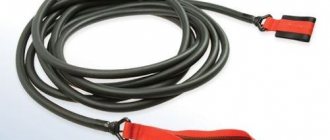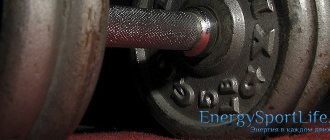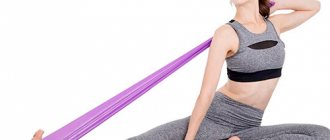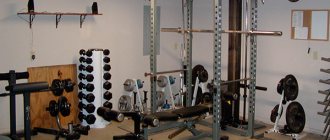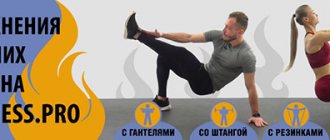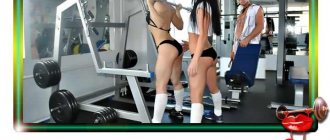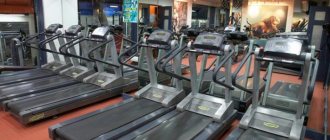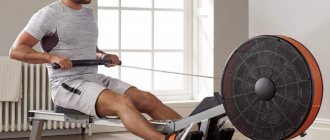Exercises with an expander: a complex for beginners
Leg exercises
Squats
Feet shoulder-width apart, hands to shoulders, rubber behind hands so as not to interfere. As you inhale, lower yourself down until your thighs are parallel to the floor, and exhale as you rise up. The exercise is simple, but due to the fact that the hands are brought to the shoulders, the load increases. If you put your hands on your belt, it will be an easier option.
Lunges
Legs in a different stance - one foot one step behind the other. Secure the expander under your front leg, holding the handles in your hands at shoulder level. Slowly bend both knees, keeping your hands on your shoulders. The knee of the supporting leg does not go beyond the line of the foot, the thigh is parallel to the floor, and the lower back is slightly bent. Control the position of your hands, the leg standing behind you bends at the knee, try to keep your body straight, do not lean forward. Return to the starting position. Perform 15 lunges and repeat on the other leg.
Starting position - lying on your side, upper leg slightly raised above the floor, foot towards you. The body and leg form a straight line. The shock absorber passes under the knee of the bent lower leg; hold it with your hand, threading it through the handles so that it does not slip. The more you pull, the higher the load will be. If you are afraid that the rubber will come off, secure it with an additional ring around the foot. Raise your leg just above 45 degrees from hip height. Return to the starting position. Repeat on the other side.
Back exercises
Seated row to the waist
Sit on the floor, shock absorber in your hands. Wrap it around your feet and grab a handle in each hand, elbows slightly bent, palms facing each other. The knees are also slightly bent, resting on the heels. The back is straight, maintain a natural curve in the lower back. Bend your elbows so that they slide along your body and pull the shock absorber handles to your lower ribs.
Deadlift standing, elbows to the side
For this exercise, the shock absorber must be secured to the external unit. We used a wall bars. At home, it can be replaced, for example, with a massive table or cabinet. You can perform the exercise on your knees from the same point for your arms, the main thing is to maintain alignment.
Fix the shock absorber on the wall at the level of the elbow joint. Step back with your arms straight ahead to a distance of light tension on the rubber. One foot one step in front of the other, lean your shoulders and body forward slightly, straighten your chest. As you exhale, pull the handles of the expander towards your chest, spreading your elbows to the sides and bringing your shoulder blades together. As you inhale, smoothly return to the starting position. The upper shoulder girdle and the “top” of the back work.
1. Before starting each workout, carefully check the rubber, stretching it slightly, for snags, cuts, microcracks and tears. If you find at least one sign of damage to the integrity of the shock absorber, throw it away to avoid injury. “One unobvious hole - and at the most inopportune moment the exercise machine can fly off, burst and injure,” warns Ekaterina Soboleva.
This is what working and damaged shock absorbers look like when tensioned. If yours looks like the one above, throw it away immediately
2. Make sure that the expander is securely fastened and will not fall off when tensioned. “A more reliable way to fix the trainer is the so-called exotic, ring twisting so that the tails hang less,” says Ekaterina Soboleva. — When winding, it is very important to center the rubber, especially if you perform symmetrical exercises, so that the same tension is felt in the starting position. When making a ring around the foot, it is important that the length of the shock absorber arms match, and the load on the right and left sides is uniform.”
3. When you press the rubber with your foot, make sure that the shock absorber is aligned with it.
4. Don't exercise barefoot. “It is imperative to perform exercises with a shock absorber in shoes,” explains Ekaterina Soboleva. — By screwing the rubber directly onto the foot, even if it is in a sock, you will create unnecessary stress on it - this is almost a guarantee that the foot will cramp. In addition, in sneakers you can be sure that the expander will not come off.”
5. It’s better to have several expanders. At least for the legs and arms. They are divided according to the degree of resistance: weak, medium, strong and ultra-strong. Weak resistance is suitable for children, teenagers, pregnant women, and older people; medium resistance is the best option for an aerobic training regimen; strong resistance will help perform leg exercises for women and basic exercises for men.
In a week we will show exercises with an expander for advanced ones. Stay tuned!
Alternating leg raises
- Lie on the floor, grab the expander in the middle, place your legs in the loops.
- Raise your body so that your lower back remains pressed to the floor.
- Overcoming the resistance of the elastic band, raise your knees one by one.
"Woodcutter"
"Woodcutter"
- Place your feet slightly wider than your shoulders, step on one end of the expander with your left foot, and grab the other end with both hands.
- Bend towards the leg under which the expander is located, keeping your back straight.
- As you straighten up, pull the expander diagonally, to the right and up, until your hands are above your right shoulder, above your head.
- Return to the left leg bend and repeat the exercise.
- Repeat on the other side.
- Hook the resistance band around your feet, twist the two ends and grasp the loops or handles in both hands.
- Stand in a prone position - a plank.
- Raise one arm and, stretching the expander, move into a side plank.
- Return to the starting position and repeat on the other side.
Exercise No. 1 Thrust of an expander from behind the head while lying down
Muscles involved: pectoral muscles, latissimus dorsi.
Slide the tube through the door or wall clamp in the down position. Fasten the tube carabiners to the handles. Lie on your back with your head towards the wall, stretch your arms towards the wall and take the handles of the expander. As you exhale, gently raise your arms forward and up to approximately chest level. Slowly return to starting position.
Exercise No. 2 Expander rows to the chest while lying down
Muscles involved: latissimus dorsi.
Slide the tube through the door or wall clamp in the down position. Fasten the tube carabiners to the handles. Lie on your stomach with your head towards the wall, stretch your arms towards the wall and take the handles of the expander, your gaze directed towards the clamp. As you exhale, gently pull the expander towards you almost until it touches your chest. Slowly return to starting position.
Exercise No. 3 Thrust of an expander to the chest while sitting
Muscles involved: rhomboid major, teres major.
Insert the tube through the door or wall clamp. Fasten the tube carabiners to the handles. Sit on the floor and take an expander. Perform abdominal pull-downs while keeping your elbows close to your body. The row can be performed from the lower fixation point.
Exercise No. 4 Seated back extension
Muscles involved: long back muscles, lower back muscles.
Slide the tube through the door or wall clamp in the down position. Fasten the tube carabiners to the handles. With outstretched arms, grasp the handles of the expander and extend your back backwards. Do not bend your elbows; perform the exercise using your back muscles.
Exercise No. 5: Expander row to the stomach while standing
Muscles involved: latissimus dorsi, deltoids, trapezius muscles.
Step on the center of the resistance band tube so that your feet are shoulder-width apart. Take the ends of the tube in your hands. Bend your legs slightly and tilt your torso forward. Slowly pull the expander towards your stomach; at the end point you can take a short pause. When performing this exercise, do not change the position of your torso and do not bend your lower back. Perform back exercises slowly.
Exercise #6 Deadlift
Step on the center of the resistance band tube so that your feet are shoulder-width apart. Take the ends of the tube in your hands. Slowly perform the expander pull to the stomach; at the end point you can take a short pause. When performing this exercise, do not change the position of your torso and do not bend your lower back. Perform back exercises slowly.
Exercise No. 7 Expander row with straight arms while standing
Muscles involved: latissimus dorsi, triceps.
Secure the expander at the top point. Attach the handles to the carabiners. Stand facing the expander and grab the handles of the expander with straight arms. Pull the expander down with straight arms until it touches the front surface of the thigh, do not bend your elbows.
Exercise No. 8 Abdominal thrust
Fix the expander in the lower position, fasten the tube carabiners to the handles. Take the handles of the expander and move away until the tube is slightly stretched. Slowly bend your elbows and pull the expander until it touches your stomach.
Exercise No. 9 Alternating bent over expander rows
Make a loop of the resistance band around your foot and step on it. Take a step back with your other leg and bend your torso forward. With your opposite hand, grab the end of the tube. Perform one-arm rows without moving or twisting your body. Perform the exercise on both sides the same number of times.
Exercise No. 10 Standing back extension
Muscles involved: erector spinae, gluteal muscles.
Take the latex tube of the expander and attach the leg cuffs to it. Place the tube over the back of your neck and insert your legs into the cuffs. Spread your back and chest wide, pushing your shoulders back, slightly arch your lower back and bend your knees. Inhale deeply and as you exhale, slowly lean forward, moving your pelvis until your body is parallel to the floor. At the same time, the back remains straight. To return to the original position, inhale, as you exhale, lift your torso and move your pelvis forward.
Exercise No. 11 Shoulder Raise (Shrugs)
Muscles involved: trapezius, rhomboids.
Examples of elastic band videos
What is the best expander to train muscles to achieve the desired effect? There is a myth among trainers that you cannot pump up with an expander at home. This is due to the fact that only one tool with a fixed load is used at all times. Initially, the exercises are difficult, but then the person gets used to the load, and the effectiveness tends to zero.
First you need to decide which muscle group you need to pump. It is best to use several simulators at once. The most optimal is a rubber expander in the form of tapes or tubes. Nowadays you can buy a set of expanders of varying degrees of complexity on the Internet. With their help you can adjust the load, increase it and ultimately get the desired result.
| hand expander |
|
| chest expander (shoulder) |
|
| tape expander |
|
| expander "Eight" |
|
| expander "Butterfly" |
|
| expanders for skiers, wrestlers, swimmers |
|
| multifunctional expander |
|
Resistance bands are becoming an increasingly popular tool for those who want to work on muscle strength and problem areas. If you have never tried exercising with a band, then you will be surprised how many benefits exercises with a seemingly ordinary elastic band bring. The elastic band is very easy to use, but extremely effective at working the muscles of the body.
This type of sports equipment is actively used in strength training, Pilates, stretching and flexibility exercises. It is also called a rubber band, shock absorber tape or thera-band. Due to its compactness and versatility, the tape is widely used in home sports. Increasingly, professional trainers are demonstrating programs using this type of equipment.
A long, wide band made of durable rubber is popular both in gyms and at home. Elastic bands were originally used in physical therapy for the elderly and for people recovering from injuries. Now this type of expander has become a complete and very convenient alternative to free weights and exercise machines.
Let's take a closer look at the benefits of training with an elastic band. Why did this type of sports equipment become so popular and even successfully compete with dumbbells and barbells?
You can buy elastic tape in sports stores. In English it is called resistance band, latex band, theraband. In Russian you can find the following names: rubber band, shock absorber band, expander band, therapeutic band, theraband or Pilates band. Unlike tubular expanders, elastic bands are often found on sale in regular stores and even, as a rule, from several manufacturers.
Elastic bands have several levels of elasticity for people with different physical fitness. Typically there are three levels of resistance: soft, medium and hard, but some manufacturers may have five or even six levels of firmness. The tapes have a specific color depending on the resistance level.
The following gradations are found:
- Yellow color: soft tape, lowest load level
- Red, green: medium load level
- Purple, lilac, blue color: rigid tape, high load level.
But we emphasize once again that color markings differ depending on the manufacturer, so it is better to look at the description of the specific product. Some online stores often sell bands of different colors, but the same resistance level. Sometimes entire sets of tapes with three levels of resistance are sold at once. Therefore, be sure to read the product description before purchasing it.
Full review of FITNESS EQUIPMENT for home
Choose a length of elastic tape that is at least 1.2 m, although they usually stretch well. However, the longer the band, the more varied exercises you can choose. In addition, a long tape can be folded in half, providing yourself with additional load. The average width of the tape should be 15-20 cm.
Like any other product, elastic band varies in quality depending on the manufacturer. Over time, the material from which the expander is made can wear out and lose strength, and this can reduce the effectiveness of exercise. The better the quality of the material, the longer it can serve you.
We offer you a unique selection of exercises with an elastic band for the upper and lower body. With these exercises you can strengthen your muscles, develop strength, improve your posture and tone your body.
Some of the exercises are done with a resistance band, but if you only have a long band, you can simply tie it around your legs. The tighter the band is, the more difficult it will be to perform the exercises, so adjust its elasticity yourself.
We offer you a ready-made exercise plan with an elastic band for the upper body (arms, shoulders, chest, back) and lower body (abdomen, hips, buttocks). You can alternate these two activities or combine them into one day if you have time.
A lot of different and inexpensive expanders are sold in the Aliexpress online store. By purchasing an elastic band, you will have the opportunity to do a variety of workouts at home very efficiently and effectively.
We have selected the most popular stores on Aliexpress with a large number of orders, high average ratings and positive reviews. The price of almost all the presented tapes is in the range of 200-400 rubles. Store links will open in a new window.
Elastic band 150 cm
The length of the tape is 150 cm, the width is 10-15 cm. The color and cost of the tape depends on the width and thickness. The thicker the tape, the greater the resistance. Made from natural latex. Cost 150-300 rubles.
Elastic band 150-180 cm
The length of the tape is 150-180 cm, the width is 15 cm. The tension of the tape is from 10 to 20 kg depending on the color (the seller indicates pounds). Made from natural latex. Cost 150-300 rubles.
Top 20 ready-made VIDEOS with elastic band
A tubular expander provides a force load on the muscles, which is created due to the resistance of the rubber. Resistance causes the muscles to contract, which stimulates the growth of bone and muscle tissue. Unlike dumbbells, an expander provides tension to the muscles throughout the entire range of motion, providing a more uniform and high-quality load. Resistance band training is safe and effective, and is therefore often recommended by physical therapists for rehabilitation after injuries.
There are many different types of expanders (hand, chest, butterfly, figure eight, ski expander, elastic band), but it is the tubular expander that is convenient and versatile for loading all major muscle groups. This type of expander is equally effective for both the muscles of the upper body (arms, shoulders, chest, back, abs) and the lower body (buttocks, legs). You can use a tubular expander:
- in strength training to build muscle
- in toning workouts to sculpt the body and increase muscle endurance
- in cardio training to burn fat
A tubular expander is made of durable thin rubber, which is shaped like a tube. The length of the expander is 120-130 cm. Depending on the hardness of the rubber, tubular expanders have several levels of resistance, which provide different degrees of load. The rigidity of an expander very often differs depending on the specific manufacturer, even with the same declared resistance level.
Fitness elastic band: what exercises are needed for
A tubular expander is a lightweight, compact and inexpensive type of equipment that will become an indispensable sports attribute both at home and in the gym. One of the disadvantages of an expander is the fact that it is not capable of providing the same level of load that dumbbells, barbells and exercise machines are capable of. If you're a serious bodybuilder, resistance bands aren't likely to help you achieve big strength training goals.
Despite all the advantages of using an expander, it can not be found in every sports store. But you can always buy a tubular expander in online markets, where, as a rule, there is a large selection of expanders of varying hardness. The only disadvantage of online purchasing is that you will not be able to visually verify the quality of the product and check the load. Please note that the stiffness of the expander may vary between different manufacturers, even with the same declared resistance.
What you should pay attention to when buying an expander:
- Tube material: Choose an expander with durable, thick rubber. Try stretching the rubber several times and check if any white streaks or defects remain on the surface.
- Handles. Handles must be made of durable plastic that is resistant to mechanical damage. Check that the handles have a rough, non-slip surface that provides improved grip while exercising.
- Fastening. With strong tension, most often the expander breaks precisely at the place where the handles and tube are attached. Ideally, choose an expander in which these parts are connected with a metal carabiner (found in expanders with replaceable tubes).
- Length. Check if you can perform exercises with an expander where you need to extend it as far as possible (for example, a shoulder press). Some expanders have such hard rubber that even with great effort they are unable to stretch to the required length.
- Additional rubber coating. An expander with a rubber tube covered with braiding or a protective sleeve (casing) is more wear-resistant and reliable for long-term use. Such expanders usually cost more.
The benefits of an expander for the musculoskeletal system
It is quite natural that most physical activities have contraindications and health restrictions. Therefore, the desire for a perfect body is often accompanied by dislocations, sprains and other injuries to the musculoskeletal system.
However, exercises with an expander (with the right choice of load) only benefit the body. They:
- strengthen ligaments, improve joint mobility;
- stimulate blood circulation;
- prevent the development of joint diseases (including in elderly people);
- form correct posture;
- restore muscle activity during post-traumatic rehabilitation;
- burn calories, tone muscles;
- develop muscle strength and endurance, contribute to the formation of beautiful relief.
You can exercise with an expander at any age. The training will benefit both children and the elderly. The main thing is that the equipment corresponds to the age category. So, elastic rubber expanders are more suitable for children and teenagers, and spring metal exercise equipment is more suitable for adults.
Goal #4. Prevention and treatment of carpal tunnel syndrome
Carpal tunnel syndrome is a problem for everyone who, day after day, is forced to make finger movements that are atypical for humans, from an evolutionary point of view. Working on a computer for more than 4 hours a day, working as a hairdresser, playing traumatic sports (basketball, for example) - all this will lead you to carpal tunnel syndrome after 5-10 years.
In its advanced form, the disease causes decreased mobility of the fingers and acute pain without an external stimulus. Failure to respond to the problem may result in disability. These consequences can be avoided by regularly working on strengthening your hands. The easiest option is to buy any wrist expander. Regular training relieves pain, strengthens arm muscles, and prevents the development of such diseases.
Exercises for legs and buttocks
- Step on the band and place your feet shoulder-width apart.
- Take the loops of the expander in your hands. To make it more comfortable to hold, pass the expander behind your shoulders and hold it in bent arms, as if placing it on your shoulder.
- Do a squat. The back is straight, the pelvis is pulled back, the knees are slightly turned outward.
- Straighten up while stretching the expander.
- Repeat the exercise.
- Hook the resistance band onto a stand close to the floor.
- Insert your ankle into the loop and lie on your stomach.
- Bend your leg at the knee, pulling on the expander.
- Straighten your leg and repeat.
What is a hand expander
Heavy physical work requires a strong grip. If a person spends days sitting at a computer, in an office with papers, or doing any other monotonous work, the strength of his hands weakens. Carrying heavy weight when necessary becomes more problematic every day. A simple exercise machine helps restore your hand grip strength. The simplest at first glance, a manual expander trains the fingers, hand, wrist and shoulder muscles. A power projectile is a small object that fits in your hand. The simplest models are made in the form of two handles with a spring or rubber.
Important! Irregular or incorrect exercises will not bring the desired result, since the muscles will receive a weak load.
Indications for use
It is recommended to perform exercises with an expander:
- schoolchildren (to strengthen muscles and form correct posture);
- beginner athletes;
- people with poor health;
- patients who have recently suffered musculoskeletal injuries.
The main thing is to choose the load based on your own capabilities.
Contraindications
An expander is a simulator on which it is simply impossible to get injured, so there are practically no contraindications to its use. Everyone can do back exercises, except people with acute joint diseases.
Top 3 manufacturers of wrist expanders
- GD is a patented, adjustable Grip Pro and Grip Ultra spring expander design made from durable gun-grade plastic. Comfortable anatomical plastic handles help you concentrate on your muscles and do not rub calluses. Cost from 1390-1690 rubles.
- Ironmind – manufacturer of resistance bands Captains of Crush has introduced a new line of wrist expanders Zenith Gripper. Hard resistance bands are designed for long life and effective training. Approximate cost 1400 rubles.
- Atomgripz - a British manufacturer produces hand expanders made of polished stainless steel called Steel Mirror Finish, which have no analogues. The cost of the brand varies around 2400-2600 rubles.
Types of expanders and how to choose the right projectile
Based on the type of load, equipment is divided into compression expanders and tension expanders. In the first case, the projectile must be compressed, and in the second, it must be stretched.
When choosing an expander, you need to pay attention to what muscles it is intended to train. Some products allow you to train a specific muscle group, while others are multifunctional and are used to develop different muscle groups. The rigidity (degree of resistance) of the expander is measured in kilograms.
Today, the following types of expanders are distinguished:
- carpal;
- shoulder (chest);
- rubber (tubular);
- latex tape;
- skier's expander;
- "butterfly";
- multifunctional.
Depending on the material, expanders are rubber, metal and plastic. Metal projectiles are intended for professional athletes, rubber ones for amateurs (including children and teenagers). As for plastic expanders, they can be both amateur and professional. However, they have a significant drawback - fragility.
Often there are products with anatomical loops for the legs or anatomical handles that follow the shape of the palm. The handles of the expander can be improved: have a massage effect or have ventilation holes.
When choosing the type and rigidity of the projectile, you need to start from what goal you are pursuing. Please note: the same muscle group can be trained using different expanders.
Your task is to choose the product that is right for you. To check how the projectile “behaves”, take it in your hands and do a few exercises. It is desirable that the resistance of the expander can be adjusted (this will allow you to gradually increase the load without risk to health).
Sports stores offer a wide selection of expanders: expensive and cheap, high quality and not so good. Experts recommend buying safe and reliable products from trusted manufacturers.
Tips for choosing an expander:
- Choose the appropriate hardness. The equipment must match your build, level of training, and goals. Professional expanders can have a resistance of more than 50 and 100 kg, and the stiffness of amateur expanders rarely exceeds 25 kg. Information about the hardness of the product must be indicated on the label. You can also pay attention to the color of the projectile: yellow – low hardness, green – higher, red – medium, blue – high.
- Inspect the product before purchasing. When choosing an expander, pay attention to the quality of the material. There should be no defects or malfunctions on the surface of the apparatus that could reduce the quality of the exercises or cause injuries.
Advantages and disadvantages
A simple expander has some advantages; this exercise machine has practically no disadvantages. It is contraindicated for people with individual intolerance to the material from which it is made. It is worth noting a huge number of its positive aspects:
- safe;
- initially it has zero load, our body itself suggests the optimal amplitude for training;
- does not require a lot of space for classes;
- you can choose the optimal length for a person’s height;
- compact and does not take up much space;
- convenient to carry;
- develops grip and impact strength;
- stimulates blood circulation and puts the central nervous system in order;
- increases endurance;
- exercises with an expander help to quickly recover from injuries;
- strengthens the muscles of the spine and chest;
- protects the spine from unnecessary stress;
- easily replaces dumbbells;
- increases muscle mass;
- acts as an anti-stress;
- There are no age or weight restrictions.
It is successfully used for home training: it is light, compact, and takes up little space.
Exercises with an expander are isolating and allow you to work out small muscle groups well.
Exercises with an expander are suitable for both men and women.
With its help, you can complicate any familiar exercise and increase the load.
You can have several resistance bands to train different muscle groups.
The undoubted benefit of the projectile is that with its help you can tone all the muscles of the body, burn extra calories and get a beautiful relief.
Before choosing an expander for your legs and buttocks, you need to study all the pros and cons of exercise machines.
Among the advantages:
- The possibility of injury is reduced to a minimum. Pregnant women, elderly people and children can freely exercise with an expander.
- Constant muscle tension is achieved without sudden changes.
- All major muscle groups are worked out (legs, buttocks, shoulder group, abdomen, arms, back).
- Easy load adjustment.
- Easy to use and store.
Among the disadvantages, users note the impossibility of pumping up bulky muscles, as with iron weights. Definitely, a rubber expander for fitness is not classified as strength equipment, and is aimed at correcting the body and partially developing it, in terms of firmness, elasticity and tightening.
A leg expander is a simple, but at the same time effective fitness equipment. You can perform many exercises with it, it is easy to use and is affordable for everyone. You just need to choose the right functional simulator.
Instructions
Select the type of resistance band. The simplest option is a rubber expander in the form of a tape. Pros: versatility and cost-effectiveness, but due to the lack of handles, using the tape is not always convenient. A tubular expander and a figure eight expander are more convenient in this regard, but the range of exercises that can be performed with their help is much narrower.
If you like static exercises, pay attention to the shock absorber ring with wide, soft cuffs with Velcro. This type of exercise machine does not allow you to do exercises with a large range of motion, but it perfectly strengthens the leg muscles. Those who need maximum load should choose a spring metal expander.
Decide what rigidity expander you need. The load the simulator will give depends on this. As a rule, expanders are color-coded. Yellow and
pink
- the simplest ones, they are intended
for children
and people with very poor physical fitness. Green is the best option for most adult women. Red – recommended for trained women and non-athletes
men
. Blue resistance bands are used by men for strength training. The rigidity of the simulator can also be indicated by the words: light, medium, hard and extra hard. There are also numerical designations: from one to three, the higher the number, the higher the rigidity.
Check if the resistance band you choose suits your physical fitness. It’s worth trying out the machine before purchasing. You must pull or squeeze the implement with force, but at the same time comfortably and confidently. When choosing, soberly assess your physical capabilities. An expander that is too hard will not allow you to perform exercises correctly, while an expander that is too soft will make your workouts less effective.
Check the quality of the parts. To do this, simply stretch the expander. If you see white stripes and microcracks
on tape
, this indicates the low quality of the rubber used in production. This type of exercise machine will not last you long. Try to choose an expander with an additional rubber coating. This way, you can protect yourself from injury even if the inner rubber band breaks.
If the expander has handles, check their comfort. Ideally, the surface of the handles should be rough and follow the shape of the palm. In this case, there is less chance that the exercise machine will slip out of wet hands during an intense workout.
How to choose a leg expander
Everyone would like to have perfect, slender legs and always be in shape, but we often don’t have enough time or money for the gym. However, you should not give up on the path to your dream. You can buy a leg expander, it is inexpensive, and it is convenient to exercise with it without leaving your room. You can buy it, and after just a few weeks of hard training you will see the results!
General rules of use
Basic rules for using an expander:
- Exercises with an expander belong to the category of strength exercises, and to grow and strengthen muscles you should not perform many repetitions (multiple repetitions of exercises are appropriate for cardio training). The optimal number of repetitions in one approach varies from 12 to 15. If you feel that the exercises are becoming too easy, you can increase the rigidity of the apparatus (add resistance).
- Before any strength loads (including training with an expander), you need to do a warm-up. During it, you should warm up those muscle groups that will be worked out during the main part of the lesson. Every workout should end with stretching. It will prevent lactic acid stagnation and help avoid discomfort the next day after training.
- Exercises with an expander should be performed smoothly. The appearance of pain during exercise indicates the presence of health problems or that you are doing something wrong.
- When performing an effort, you need to “hang” in this position for a few seconds, and only then return to the starting position.
- Before you start training, you need to make sure that the expander is firmly attached to the wall or horizontal bar and is not damaged. The presence of microcracks, problems with fastening - all this can cause the cord to break at the most inopportune moment and lead to injury.
- It is advisable to exercise with an expander in shoes. If you catch a dense projectile on an unprotected foot, you can get calluses and cramps.
1. Perform all exercises 15 repetitions, swings - 20-25 (they are simple and not energy-intensive). If you are a complete beginner, start with one set. Monitor the degree of fatigue: if you feel good at the next workout, increase the number of approaches to two; if your muscles hurt, repeat the session unchanged.
2. Be sure to warm up before training, never exercise “cold”. At the end - basic stretching as a cool-down, so that the pulse calmly drops and the muscles stretch. “A transition from active exercise to a resting phase is definitely needed,” comments Ekaterina Soboleva. “The body can react ambiguously to sudden changes in physical activity, so you need to enter and exit training smoothly.”
3. Make sure that the rubber is always in tension; if it sag, you are not working. “If possible, perform leg exercises with an expander harder - it will be more effective,” says Ekaterina Soboleva.
Expander “Butterfly” – contraindications
The main point of concern when preparing for exercises with an expander is the condition of the blood vessels and capillary network. Be careful and selective about training with an expander in case of various cardiovascular diseases, established degrees of diabetes, hypertension, oncology, the presence of warts, papillomas and fresh wounds on the hips and feet.
The rest get down to business with pleasure, not forgetting that only regular exercise can give a worthwhile result. The system in training is recognized as more important than the choice of expander. The exercise machine is designed to work for the benefit of the body and business, and not lie in the corner of the closet. Let's look at the basic exercises with an expander for the legs and buttocks, performed using a group of simulators.
The proposed strength exercises for the legs and hips are performed using a “Butterfly” expander, which gives an effective picture of the results of training these areas of the body. This is a strength trainer that helps in 20 minutes. daily workouts to tidy up problematic female areas: hips and buttocks.
In order for training to bring only benefits, it is important not to overload the body and take into account existing contraindications. You should not exercise if there is fragility of blood vessels and capillaries, hypertension and diseases of the cardiovascular system. Exercises are contraindicated for diabetes, oncology, skin diseases and injuries. The Butterfly expander can be used during pregnancy only with the permission of the attending physician.
Price
There are different types of hand expanders available for sale. Depending on the manufacturer, the cost of simulators in Moscow and St. Petersburg varies from 125 to 2000 rubles:
| Name | Description | Price, rub.) |
| Adjustable Dinosaur Hunter | Hardness (kg): 24-30, 28-45, 40-68, 53-88, 72-133, 90-155 | 1 750 |
| Gyroscopic hand trainer Power Ball | Luminous, body – polycarbonate, anti-slip rim – rubber, cord – nylon, diameter 7.5 cm, orange | 1 190 |
| Gyroscopic hand trainer Power Ball Wrist | A small ball that works on the principle of a gyroscope. | 650 |
Cheaper models cost up to 300 rubles. There are both spring and ring projectiles:
| Name | Description | Price, rub.) |
| Wrist spring Es-301, | Hard handle, load: 10 kg, gyroscopic, green | 290 |
| Wrist spring ES-304 | Soft handle, green/grey, load: 20 kg, gyroscopic | 249 |
| Wrist ES-401 Ball | Green, load: 20 kg, gyroscopic | 149 |
| Carpal expander, ring | Black, adult | 125 |
Sales are carried out in any convenient way. The projectile can be purchased in a specialized or online store. There are often discounts and sales. In this case, the purchase will not be very expensive. When making an online purchase, reliability and quality assurance are high. Delivery is carried out by mail, courier, pickup is possible.
Exercises using the Bubnovsky method
Bubnovsky’s exercises allow you to quickly eliminate the symptoms of spinal hernia, osteochondrosis, as well as:
- curvature of the spine;
- disc displacement;
- pain of unknown etiology;
- increase endurance;
- strengthen the elasticity of muscles and ligaments.
Exercises:
- Take the projectile in your hands and fix it, rest your feet on it and take a position at an angle of 90°. Slowly return to the starting position and repeat the procedure 20 times. Repeat the exercise 3 times a week.
Exercises with an expander for women are aimed at different muscle groups. - Sit on a chair, bench, with a straight back, rest your feet on the floor. Fix the hand sports tool at the bottom and straighten the expander at an angle of 45 degrees. Repeat the exercise 5-10 times, with a break of 10 minutes, do one more approach. Repeat the exercise 3 times a week.
Back exercises
Exercises:
- Pistol squat. You need to fix the expander on the high crossbar of the horizontal bar, straighten your back and take the handles of the tool in your hands. Squat, straightening one leg. Repeat the procedure with each leg alternately 30 times, with an interval of 3 minutes between exercises.
- "Standing deadlift." Place the expander on a trainer or horizontal bar, and take the other side in your hands. Stand up straight and extend one leg at a right angle. Pull the expander towards and away from you.
- "Twisted." You will need to properly fix the training apparatus on the simulator, stand with your back to it and take the handles of the expander in your hands. Take a step forward and wave your hand. Repeat the exercise 10 times for each hand.
What muscles does the expander develop?
If anyone thinks that the benefit of a manual expander lies in training the fingers and hand, then he is greatly mistaken. The wrist trainer makes the triceps, biceps, and forearm muscles tense. It is for this reason that it is necessary to follow the training rules. With irregular exercise, instead of good muscles, a person will get a sprain. Sometimes too high loads cause great harm to the body in the form of a hernia.
Several features of training for men and women - what is the fundamental difference
When performing exercises with a wrist expander, you must adhere to the training rules for men and women. They also apply to complex strength training. Muscle mass in men is approximately 10% greater than in women. This is how nature designed it: women’s muscles have more layers of fatty tissue and are less dense.
That is why the fair sex is recommended to primarily train not strength, but endurance. It is better to choose a weaker expander, but train with it longer and do more approaches. For men, it is advisable to exercise with a rigid simulator, which requires a serious load on the muscles, and the number of approaches can be reduced.
